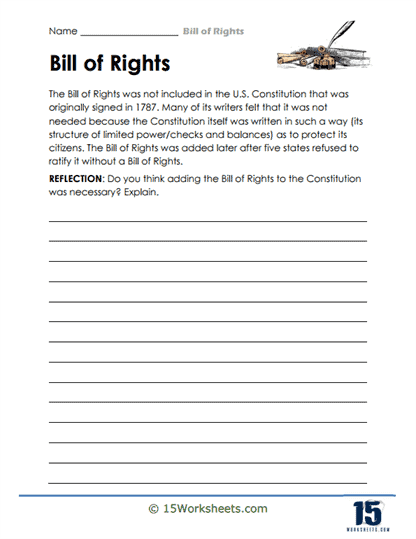Historical Backdrop

Worksheet Description
This worksheet focuses on the historical backdrop of the U.S. Bill of Rights, highlighting its absence in the original Constitution drafted in 1787. It elaborates on the belief held by many drafters that the Constitution’s inherent design of checks and balances and limited power was sufficient to safeguard the rights of the citizens. The exercise accentuates a pivotal moment in history when the Bill of Rights was eventually incorporated after five states declined to ratify the Constitution without it. The culminating reflective section propels students to ponder and articulate whether the addition of the Bill of Rights to the Constitution was indeed indispensable.
To proficiently tackle this worksheet, students should first immerse themselves in the historical context surrounding the drafting and subsequent ratification of the U.S. Constitution. They should understand the reasons why some felt the initial Constitution was adequately protective without an explicit Bill of Rights. After grasping the circumstances leading to the eventual inclusion of the Bill of Rights, students should introspectively assess its significance and necessity. Drawing from their understanding, they should then formulate a well-thought-out response to the reflection question, substantiating their perspective with historical facts and reasoning.
The core objective of this worksheet is to foster a deeper understanding of the evolution and nuances of the U.S. Constitution, particularly the circumstances that precipitated the inclusion of the Bill of Rights. It aims to instill an appreciation for the historical debates and concerns that shaped the nation’s foundational documents. By reflecting on the necessity of the Bill of Rights, students are encouraged to develop critical thinking and evaluative skills, weighing the implications and significance of this landmark addition. Ultimately, the worksheet aspires to produce informed individuals who can critically engage with historical documents and appreciate the multifaceted debates that underpin them.
